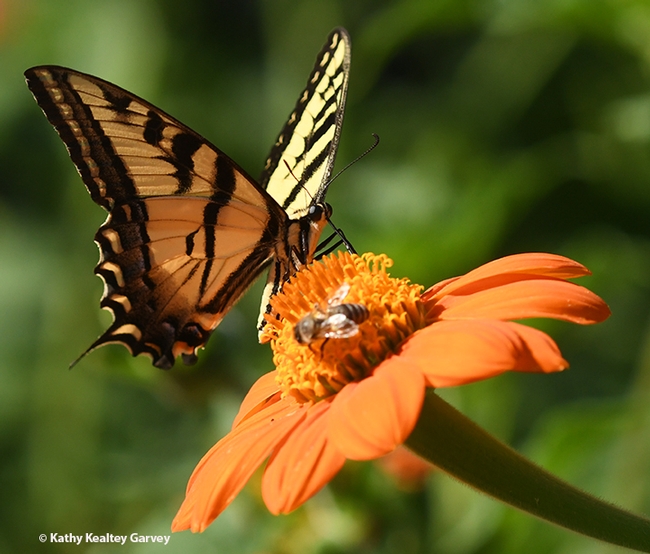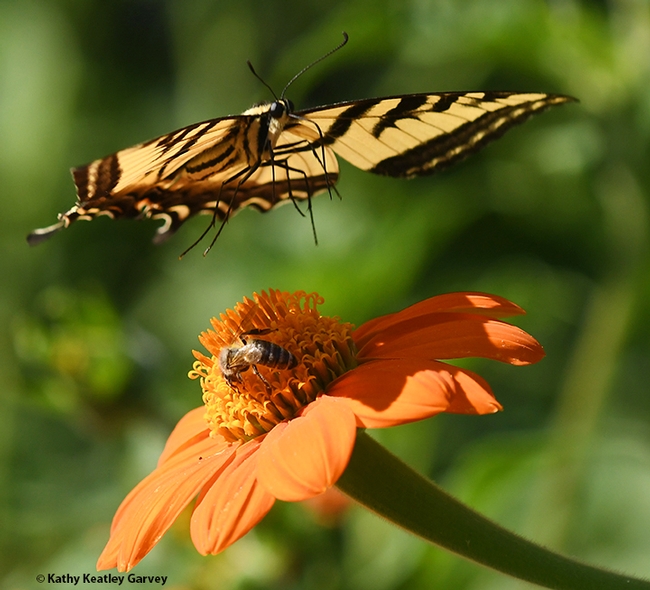- Author: Kathy Keatley Garvey
So, here you are, a newly eclosed Western tiger swallowtail, Papilio rutulus, eager to sip some nectar from a Mexican sunflower, Tithonia rotundifola, in a Vacaville garden.
It's a warm, windless day, and you're anxious to score, score, score.
You touch down on a Tithonia, but something whizzes by your tails.
Whoa! What was that?
You're startled, alarmed, and irritated. It's a territorial male long-horned bee, probably a Melissodes agilis. He aims to dislodge you from your blossom in his attempt to save the nectar for his would-be girlfriends.
You teeter, then totter, then take off. You touch down on another Tithonia.
Hey! Bee brain! Quit targeting me? Go away!
You head for another blossom, determined to grab a least "a little" nectar.
Stop it! Leave me alone! Go take a vacation!
But the bee isn't about to take a vacation. And he won't allow your "staycation."
Spoiler alert: The butterfly admits defeat and departs the flower garden, exasperated but with tails intact. The bee emerges victorious, its real estate intact.
Score: Bee, 3, Butterfly, 0.
The turf battle is over for today. Tomorrow? That's another day and another battle.
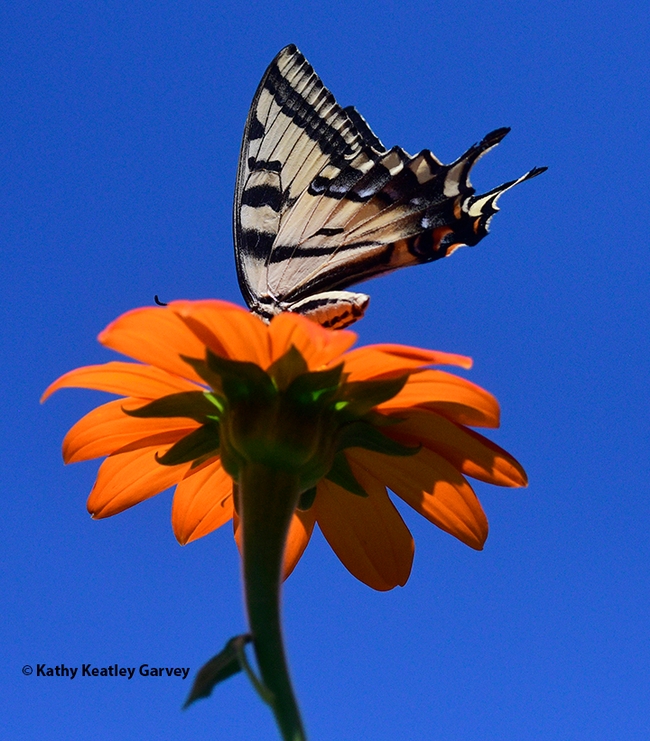
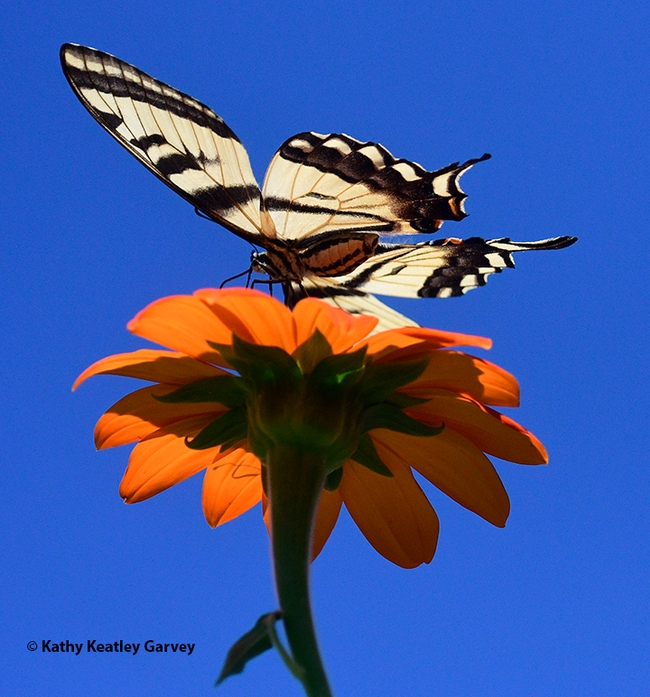
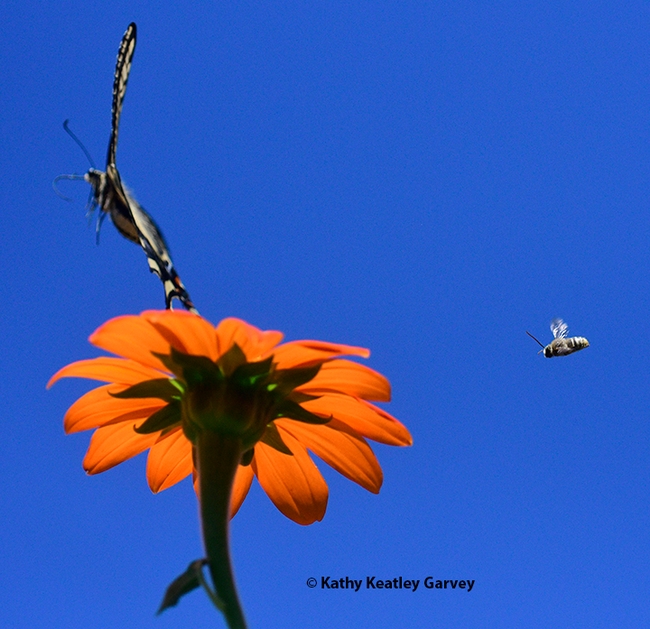
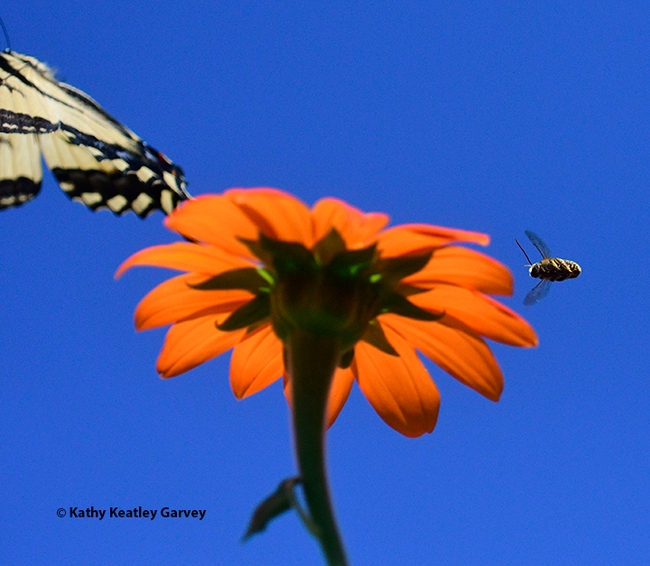
- Author: Kathy Keatley Garvey
When a tiger meets a Tithonia, or a Tithonia meets a tiger, Nature bursts forth in all its glory.
Such was the case when we spotted a Western tiger swallowtail, Papilio rutulus, foraging for nectar on a Mexican sunflower, Tithonia rotundifola, in a Vacaville garden.
It was a newly eclosed swallowtail in perfect form, devoid of ripped, stripped and shattered wings signifying non-successful predatory attempts.
The magnificent butterfly fluttered over the Tithonia, sometimes chased by a territorial longhorned bee. But still it cruised. It raced. It soared.
Spread your wings, little tiger. You have no claws, but you need not pause. The Tithonia, the touchdown, the nectar--they're all yours for the taking.
(Taken with a Nikon D500 with a 200mm lens. Settings: Shutter priority, 1/4000 of a second; f-stop, 6.3; and ISO 800.)
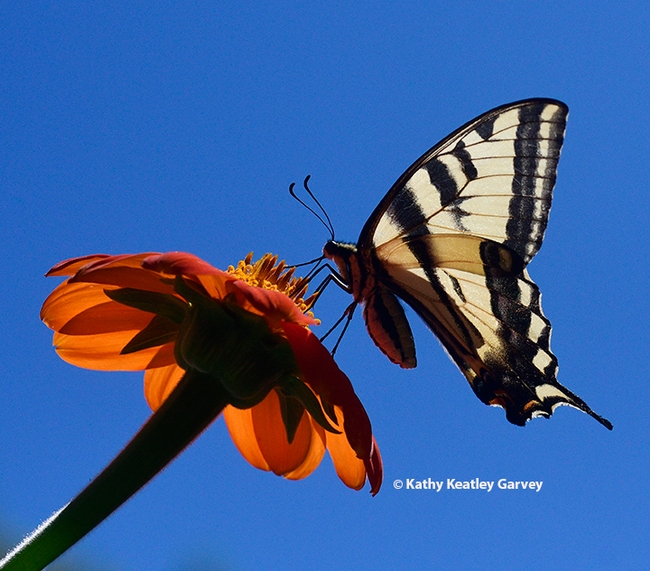
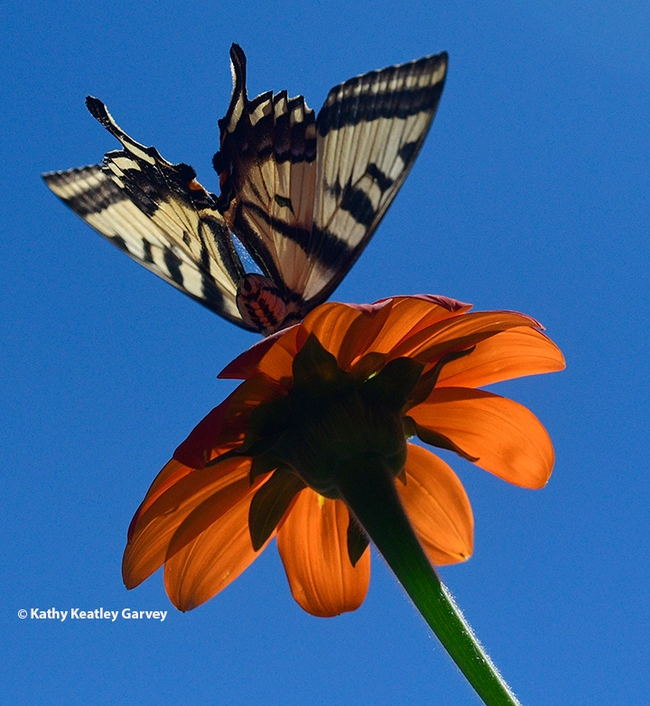


- Author: Kathy Keatley Garvey
When a newly eclosed Western tiger swallowtail, Papilio rutulus, lands on a butterfly bush, the colors are striking.
The yellow and black butterfly contrasts well on the purple blossoms of Buddleja davidii.
While the majestic butterfly is widely loved, the plant, also called summer lilac, is not. It's considered an ecological threat and a noxious weed by the Invasive Plant Atlas of the United States: "Buddleja davidii readily invades disturbed sites and riparian areas. Although butterflies will use this plant as a nectar source their larvae cannot survive on it. By replacing native larval food source plants butterfly bush can have a negative impact on wildlife."
B. davidii is native to Sichuan and Hubei provinces in central China, and also Japan. The genus, Buddleja, is named for the Rev. Adam Buddle, an English botanist. The species name honors Father Armand David, a French missionary and explorer in China, Father Armand David, who was the first European to report the shrub, according to Wikipedia. It won the RHS Award of Merit in 1898, and the Award of Garden Merit (AGM) in 1941.
Now nurseries are selling non-invasive hybrids, with such names as "Lo and Behold" and "Blue Chip" and "Flutterby."
Nevertheless, who can resist photographing the Western tiger swallowtail as it stops to nectar on a butterfly bush?
Lo and behold...
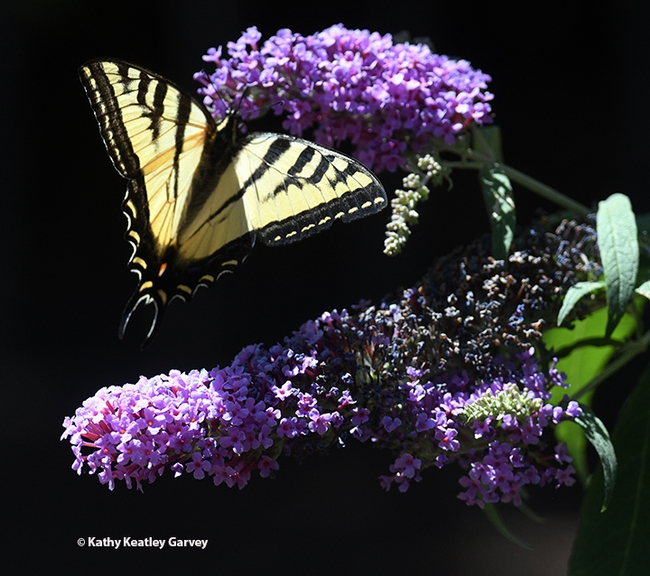
- Author: Kathy Keatley Garvey
It's not "officially" spring until we see--and photograph--the spectacular Western tiger swallowtail, Papilio rutulus.
That's what I posted April 2, 2021 on Bug Squad after seeing one land March 30 on a white lilac bush in a Vacaville park. It lingered long enough for a few photos and then fluttered away.
This butterfly's wings are a brilliant yellow with black stripes. Blue and orange spots accent the "tails" on its hindwings.
Fast forward to today: The Entomological Society of America (ESA) has before its members, a proposal to add the common name, "Western Tiger Swallowtail,” to the scientific name, Papilio rutulus.
Most of us have not called it anything else. Oh, wait, there was "That Big Yellow Gorgeous Butterfly" and "Ol' Yeller" and "Sunshine Butterfly."
The ESA-approved name, if the members agree, would be "Western tiger swallowtail." Yes!
Presently there are 10 species within the family Papilionidae that have common names established by ESA. None describe species that are primarily found west of the Mississippi.
"Western" reflects its broad distribution over the western United States, as ESA says. "It is the most abundant of the 'tiger swallowtails' in this part of the U.S., paralleling the distribution of Papilio glaucus (tiger swallowtail/'eastern tiger swallowtail') which is the most abundant species in the eastern United States."
Also up for discussion and approval are these proposals for common names:
- "Two-tailed swallowtail" for Papilio multicaudata
- "Eastern tiger swallowtail" for Papilio glaucus
- "Pale swallowtail" for Papilio eurymedon
See the ESA database of common names, which includes more than 2,000 common names of insects and is searchable by common name, scientific name, author, order, family, genus, and species.
Butterfly guru Art Shapiro, UC Davis distinguished professor of evolution and ecology who maintains a research site, Art's Butterfly World," monitoring the butterfly populations in Central California since 1972, has always called Papilio rutulus by the common name of Western tiger swallowtail. But mostly he calls it Papilio rutulus. He writes on his website:
"The Western Tiger Swallowtail is basically a species of riparian forest, where it glides majestically back and forth along the watercourse. It has expanded into older urban neighborhoods where several of its host genera are grown as shade trees, and behaves as if the street were a watercourse. In the high country and on the Sierran east slope its usual host is Aspen."
"One brood (June-July) at higher elevations; one and a partial second at Washington; 2-3 at lower elevations with a long flight season (late February or March-September or October). An avid puddler. Visits Yerba Santa, California Buckeye, Milkweed, Dogbane, Lilies, Coyotemint, etc., etc. and in gardens frequent at Lilac and Buddleia. Spring individuals are smaller and usually paler than summer. Low-elevation hosts include Sycamore (Platanus), Ash (Fraxinus), Cherry and other stone fruits (Prunus), Willow (Salix), Privet (Ligustrum), Lilac (Syringa) and (in Sacramento County) Sweet Gum (Liquidambar)."
Have you seen any Papilio rutulus this year? Or the Western tiger swallowtail? Or "That Big Yellow Gorgeous Butterfly?"

- Author: Kathy Keatley Garvey
Are you tired of the triple-digit temperatures? Wish someone would throw a breeze your way and provide a little shade?
A honey bee foraging on a Mexican sunflower (Tithonia rotundifola) probably felt a slight breeze when a Western tiger swallowtail (Papilio rutulus) fluttered down and landed next to her.
This is a two-insect blossom now.
Butterfly: "Bee, what are you doing?"
Bee: "Sipping some nectar, same as you."
Butterfly: "Bee, don't get any closer."
Bee, edging closer. "But I was here first. The nectar is excellent."
Butterfly: "Go away."
Bee: "No."
Butterfly: "Then I will." The butterfly lifts off.
Bee: "Thanks for the shade. You make a good umbrella, Madam Butterfly. Come back anytime."
